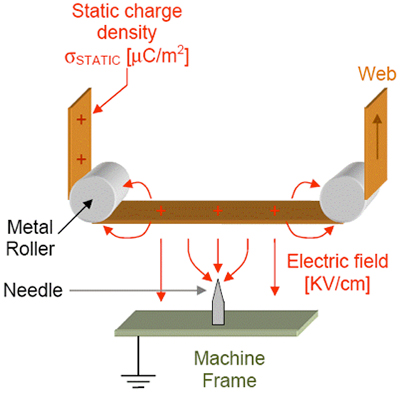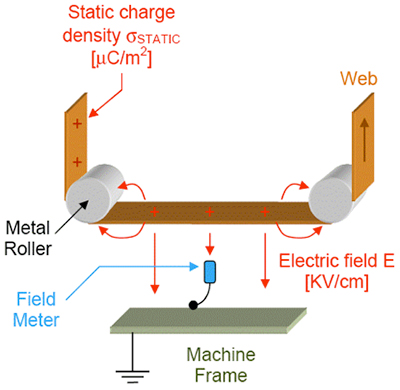Static Beat | How Do Passive Dissipaters Neutralize Static?
- Published: February 25, 2013, By Kelly Robinson
Static charge can shock operators, ignite flammable solvent vapors, and attract dust to product. In emerging products, static charge can damage printed electronic devices and shift the performance of chemically and biologically active coatings for sensor applications. Passive dissipaters, like static brushes, pin arrays, tinsel, and ionizing cords, or active dissipaters, such as AC static bars, are used to neutralize static. Understanding how passive ionizers work helps you decide when to use them and where to install them along a web conveyance path.
Early passive static dissipaters were simply a row of grounded needles. The needle located near the web in Figure 1 is one needle in a dissipater. Electric fields flow from static charges on webs to nearby grounded objects. For example, for areas of webs near rollers, the electric field flows to the rollers. And, for areas of the web away from the needle and the rollers, the electric fields flow towards the grounded machine frame, and they are approximately uniform.


The static charge density σSTATIC in equation (1) is the source of the electric field E flowing from the web toward the machine frame.
However, near the sharp tip of the needle, the electric fields are much stronger. Typical passive dissipaters in good working order intensify the electric fields by a factor in the range 15–60. Higher intensification is better.
Now, air can only withstand electric fields of about 30 KV/cm, which is the breakdown strength of air. Electric fields above this threshold cause the molecules of nitrogen and oxygen in air to ionize. So, the intense electric field near sharp points generates a corona discharge that forms both positive and negative ions. In Figure 1, negative corona ions follow the electric fields towards the positive static charges on the web. And, the positive corona ions impinge on the pin point and dissipate quickly to ground. This is how passive dissipaters neutralize static on webs.
Passive static dissipaters have two key performance characteristics that follow from their operation by field intensification.
- Passive dissipaters respond just like fieldmeters.
- Passive dissipaters leave a low level of static on webs.
Passive static dissipaters respond just like fieldmeters in that they require an electric field to work. Imagine in Figure 2 that we replace the needle with an electric fieldmeter. The fieldmeter measures the approximately uniform electric field flowing from the static charges on the web to the grounded machine frame. So, we can use equation (1) to determine the static charge density σSTATIC on the web.

For a passive static dissipater to work, the fieldmeter reading must exceed a threshold in the range ±0.5 – ±2.0 KV/cm. When the fieldmeter reading is too low, the intense electric field at the needle tip is below the breakdown strength of air. With no corona discharge, no corona ions are generated and our passive static dissipater is inactive. For best operation, passive dissipaters should be installed away from idler rollers where the electric fields are higher. Passive dissipaters installed near rollers are ineffective.
Passive dissipaters leave a low level of static on the web. When the web in Figure 1 has a high level of static charge exceeding about ±5 μC/m2, the electric fields flowing from the web toward nearby grounded objects exceeds ±6 KV/cm. The intensified electric fields near the sharp tips of the passive static dissipater exceed the breakdown strength of air and corona ions are generated. Corona ions flow towards the web to dissipate the static. As the static charge is dissipated, the electric fields decrease and the corona discharge at the sharp points ceases. No more corona ions are generated and our passive static dissipater is inactive. The web exits with a charge density in the range of about ±0.4 to 1.8 μC/m2.
Passive static dissipater such as brushes, tinsel strands, and ionizing cords generate corona ions by intensifying the electric field flowing from static charge on the web. To operate effectively, passive dissipaters must be installed on free spans away from idler rollers and other conducting objects. Use an electric fieldmeter to verify that the field exceeds a threshold in the range ±0.5 – 2.0 KV/cm for a passive static dissipater to work. This threshold for operation also means that passive static dissipaters leave a low level of static on the web. While passive static dissipaters can prevent incendive discharges, this low level of static may be objectionable for printed electronic devices or for coatings for chemically or biologically active sensors.
Static control expert Dr. Kelly Robinson, president of Electrostatic Answers, has 27+ years of experience in problem-solving and consulting. Contact him at 585-425-8158; kelly.robinson@electrostaticanswers.com; www.electrostaticanswers.com.












